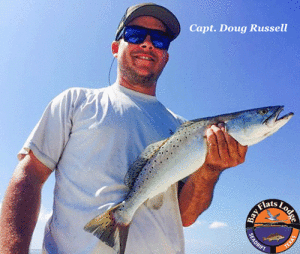
Fishing the past couple weeks has been “really good” on certain days, and then just “good” on others. The term “really good” refers to days consisting of trout limits, and just “good” means anglers are catching trout, but just maybe not in the total numbers that everyone would like to recognize on a given day. This inconsistency has to be due primarily to the variations in the weather that our part of the coast has experienced lately. For example, the weather one day sends us a beautiful and windy high-pressure day, but our fishing efforts produce a diminished result of only ten to fifteen trout and (maybe) a couple redfish. Then, over the course of the next day or so, we may be faced with a windy low-pressure day, and our results double. Regardless, there has been a definite increase in trout action and a steady tapering-off of redfish catches with the warming of bay waters. Water temperatures have risen and are now staging in the low to mid 80’s each day, meaning there’s no need any longer for the use of chest waders if you want to try some wade fishing this month. However, it is strongly suggested that you wear long pants, as warmer waters tend to attract many of the seasonal jellyfish that can make for a very uncomfortable day of wade fishing if you are wearing shorts.
At this time, water clarity along leeward shorelines is nice enough to truly be deemed “trout water”, and these areas are holding good trout right now, as well as the open-water reefs out in the middle of San Antonio Bay. When attempting to decide where to stop the boat and to begin your wade session, it’s important to key on any bait activity along these leeward shores. Look for the obvious nervous water conditions, and the usual active and moving mullet. But even more importantly, scan the area for small slicks that may be popping up close to the bank or near the grass/sand transition. Try to position your wade upwind of the slicks if you’re throwing lightweight baits. If you’re tossing some heavier tackle, like large-sized top waters, you can often setup downwind of the slicks and still cast effectively over the targeted area. Check in all directions for birds sitting atop the water, or for cranes that may be standing right against the edge of the shore. Look for small patches of grass within a wavy sand bottom contour. Many anglers prefer wading sandy shorelines that have significant guts, not ones that drop-off slowly, but ones that closely resemble the first, second, and third guts that are commonly found along a beachfront.
A typical scenario anglers might like to adopt this month would be to begin in the predawn light by presenting top water baits up close to the shore and within the first gut. As the light of day grows in intensity, proceed to the second and then the third gut. This drill allows you to thoroughly work the shallows for about the first hour of the day before following the bait out to deeper water. Top water action in the skinny water has been good, but more for short strikes than anything else, but it’s just a matter of time before it will turn on strong. Recent top water results have improved significantly in deeper water, over sand and over shell. When working surface walkers in deep water, work the bait fast until you get your first slap or blow up. The best rod tip action is that of a sudden stop, or an action that goes from fast to that of a gradual slow down, and then back to fast again. This erratic type of action has proven itself time and time again in deeper water, whereas in shallower water an even tempo and smooth, slow retrieve seems to be the ticket. Try these lure-fetching techniques during your next top water wade session and see if they help.
Fishing with any level of success during the summertime months can often prove to be a difficult time for artificial lure enthusiasts. Bay waters at this time of the year are teaming with natural baits of all sorts, and there’s definitely an increased amount of boat traffic and fishing pressure. So, what’s a lure chunker to do? Work harder is the answer. If you are of the belief that you will be rewarded simply due to the fact that you were on your feet all day long, then you are fooling none other than yourself. However, for those who are willing to dish out 100% effort, the rewards can be very gratifying. Go with what you know, but don’t be afraid to try new things.
If the area you’re fishing isn’t producing, move to another spot containing fish signs. If your lure isn’t working, revert back to one that you are most confident in – your “go to” bait. And if you’re getting too discouraged at the fact that you’re not doing well, then remember…just Keep Grinding!
